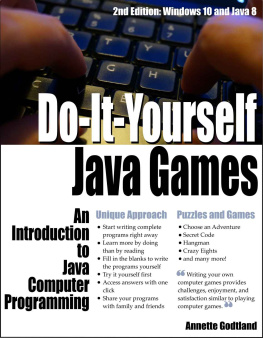Mr Kotiyana - Java
Here you can read online Mr Kotiyana - Java full text of the book (entire story) in english for free. Download pdf and epub, get meaning, cover and reviews about this ebook. year: 2017, genre: Computer. Description of the work, (preface) as well as reviews are available. Best literature library LitArk.com created for fans of good reading and offers a wide selection of genres:
Romance novel
Science fiction
Adventure
Detective
Science
History
Home and family
Prose
Art
Politics
Computer
Non-fiction
Religion
Business
Children
Humor
Choose a favorite category and find really read worthwhile books. Enjoy immersion in the world of imagination, feel the emotions of the characters or learn something new for yourself, make an fascinating discovery.
- Book:Java
- Author:
- Genre:
- Year:2017
- Rating:3 / 5
- Favourites:Add to favourites
- Your mark:
- 60
- 1
- 2
- 3
- 4
- 5
Java: summary, description and annotation
We offer to read an annotation, description, summary or preface (depends on what the author of the book "Java" wrote himself). If you haven't found the necessary information about the book — write in the comments, we will try to find it.
Java — read online for free the complete book (whole text) full work
Below is the text of the book, divided by pages. System saving the place of the last page read, allows you to conveniently read the book "Java" online for free, without having to search again every time where you left off. Put a bookmark, and you can go to the page where you finished reading at any time.
Font size:
Interval:
Bookmark:
Copyright 2017 by Mr Kotiyana
All rights reserved. No part of this publication may be reproduced, distributed, or transmitted in any form or by any means, including photocopying, recording, or other electronic or mechanical methods, without the prior written permission of the publisher, except in the case of brief quotations embodied in critical reviews and certain other noncommercial uses permitted by copyright law .
Table of Contents
1) Introduction Basic
1.1 What This Book Is About?
1.2 Why Read This Book?
1.3 Do I Need to Know Math?
1.4 Programming as a Form of Expression 9
2) Programming Basics
2.1 What is Programming?
2.2 What is Data?
2.3 Understanding Variables.
2.4 Naming Variables.
2.5 Keywords
2.6 Tokens
2.6.1 Writing Java
2.6.2 Separator Tokens
2.6.3 Operator Tokens
2.6.4 Literals
2.7 What are Functions?
2.7.1 Parameter Lists
2.7.2 Side Effects
2.7.3 Multiple Arguments
2.8 Logic and Operators
2.9 Return Keyword
2.10 Class/Static Variables
2.11 Arrays
2.12 Loops
2.13 Classes
2.14 Introduction to Objects
2.14.1 Characteristics of OOP 68
2.14.2 An object has an interface 70
2.14.3 An object provides services 73
2.14.4 The hidden implementation 75
2.14.5 Reusing the implementation 77
2.14.6 Inheritance
2.14.7 Polymorphism
2.15 Types
2.15.1 Value and Reference Types 87
2.15.2 Strong Typing
2.16 Thinking in Algorithms.
2.17 Statements and Expression.
2.18 Learning to copy & paste code. 99
2.19 Understanding floating points. 101
2.20 The Big O Notation.
3) Data Structures
3.1 Binary Search.
3.2 Bubble Sort
3.3 Insertion Sort
3.4 Merge Sort.
3.5 Quick Sort.
3.6 Selection Sort
3.7 Linked List
) Network Programming
4.1 What is network programming
4.2 Socket Programming
4.3 URL Processing
5) Tips and Advice
5.1 Skills self-taught programmers commonly lack.
5.2 Important data structure and algorithms
5.3 9 ways to become Great Programmer.
5.4 4 Secrets of Great Programmers.
5.5 Difference between a programmers, a good Programmer and a great programmer.. 194
6) 4 Reasons why Your Program Crashes
7) Programming Quotes!
CHAPTER 1 | Introduction
What This Book Is About
This book was written as an answer for anyone to pick up a programming language and be productive. You will be able to start from scratch without having any previous exposure to any programming language. By the end of this book, you will have the skills to be a capable programmer, or at least know what is involved with how to read and write code. Afterward you should be armed with the knowledge required to feel confident in learning more. You should have general computer skills before you get started. After this youll know what it takes to at least look at code without your head spinning.
Why Read This Book?
You could go online and find videos and tutorials to learn; however, there is a distinct disadvantage when it comes to learning things in order and in one place.
Most YouTube or tutorial websites either gloss over a topic or dwell at a turtles pace for an hour on a particular subject. Online content is often brief and doesnt go into much depth on any given topic. It is incomplete or still a work in progress. Youll often find yourself waiting weeks for another video or tutorial to come out.
Most online tutorials for Java are scattered, disordered, and incohesive. It is difficult to find a good starting point and even more difficult to find a continuous list of tutorials to bring you to any clear understanding of the Java programming language. Just so you know, you should find the act of learning exciting. If not, then youll have a hard time continuing through to the end of this book. To learn any new skill, a lot of patience is required.
I remember asking an expert programmer how Id learn to program. He told me to write a compiler. At that time, it seemed rather mean, but now I understand why he said that. It is like telling someone who wants to learn how to drive Formula 1 cars to go compete in a race. In both cases, the learn part was left out of the process of learning. It is very difficult to tell someone who wants to learn to write code where to begin.
However, it all really does start with your preparedness to learn. Your motivation must extend beyond the content of this book. You may also have some preconceived notions about what a programming is.
I cant change that, but you should be willing to change your thoughts on the topic if you make discoveries contrary to your knowledge. Keep an open mind.
Computer artists often believe that programming is a technical subject that is incompatible with art. I find the contrary to be true. Programming is an art, much as literature and design is an art. Programming just has a lot of obscure rules that need to be understood for anything to work.
Do I Need to Know Math?
With complex rules in mind, does programming require the knowledge of complex mathematics? Actually, unless you program mathematical software, only a bit of geometry is nice to have. Most of the examples here use only a tiny bit of math to accomplish their purposes.
Mathematics and programming do overlap quite a lot in their methodology. Math taught in schools provides a single solution. Programming results tend to behave a bit like a math proof, but only the proof isnt just another bit of math. Rather, the proof of your code means that your zombies chase after humans.
A considerable amount of math required has been done for you by the computer. It is just up to you to know what math to use, and then plug in the right variables.
Programming as a Form of Expression
There is a deeper connection between words and meaning in programming. This connection is more mechanical, but flexible at the same time. In relation to a programming language, programmers like to call this expressiveness. When you write words in literature, you infer most if not all of the meaning. When programming inference isnt implied, then youre free to define your own meanings for words and invent words freely.
One common merging of art and code appears within a video game. Anytime characters can react to each other and react to user interaction, which conveys a greater experience. An artist, an animator, or an environment designer should have some ability to convey a richer experience to the audience. A character artist can show a monster to his or her audience; but to really experience the creature, the monster should glare, grunt, and attack in reaction to the audience.
Chapter 2 | Programming Basics
What Is Programming?
Its all about writing code. Programming is a process in which we organize data and use logic to do something with those data. The data are everything a computer can store; they can range from numbers to zombie characters in a video game.
You do this by writing text into files called source code. Source code written into text files replaces punch cards used by the computing machines half a century ago.
When data are combined with logic and then written into a single file, theyre called a class. Classes are also data, and as such can be managed with more logic.

Classes are used to create objects in the computers memory and can be duplicated to have a life of their own. Classes are used to build objects. Each piece of data within the class becomes a part of that object. Different chunks of data inside of a class are called class members.
Font size:
Interval:
Bookmark:
Similar books «Java»
Look at similar books to Java. We have selected literature similar in name and meaning in the hope of providing readers with more options to find new, interesting, not yet read works.
Discussion, reviews of the book Java and just readers' own opinions. Leave your comments, write what you think about the work, its meaning or the main characters. Specify what exactly you liked and what you didn't like, and why you think so.

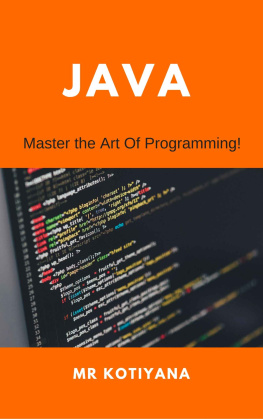
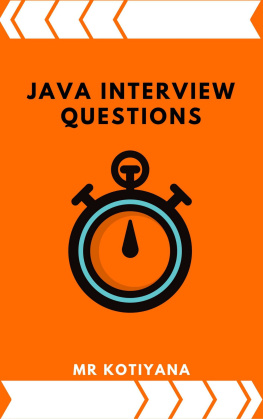
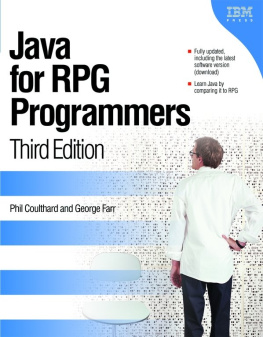

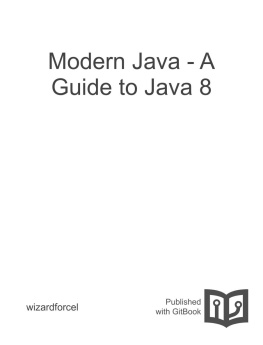
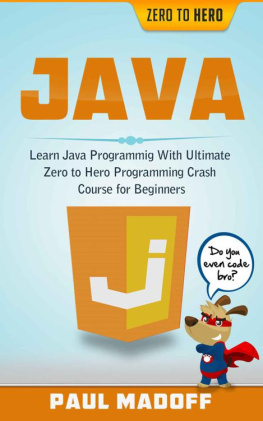
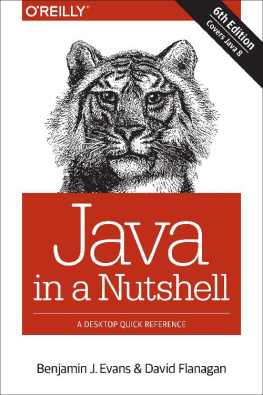
![Mr Kotiyana [Kotiyana] - Java: Start your programming career by learning Java and teach yourself to develop professional applications for desktop PCs such as utilities and games. (The Complete Reference)](/uploads/posts/book/114985/thumbs/mr-kotiyana-kotiyana-java-start-your.jpg)
![Nzenwa I. U - Java Basics: An intro to Java and the Java developement [development] environment](/uploads/posts/book/109245/thumbs/nzenwa-i-u-java-basics-an-intro-to-java-and-the.jpg)
